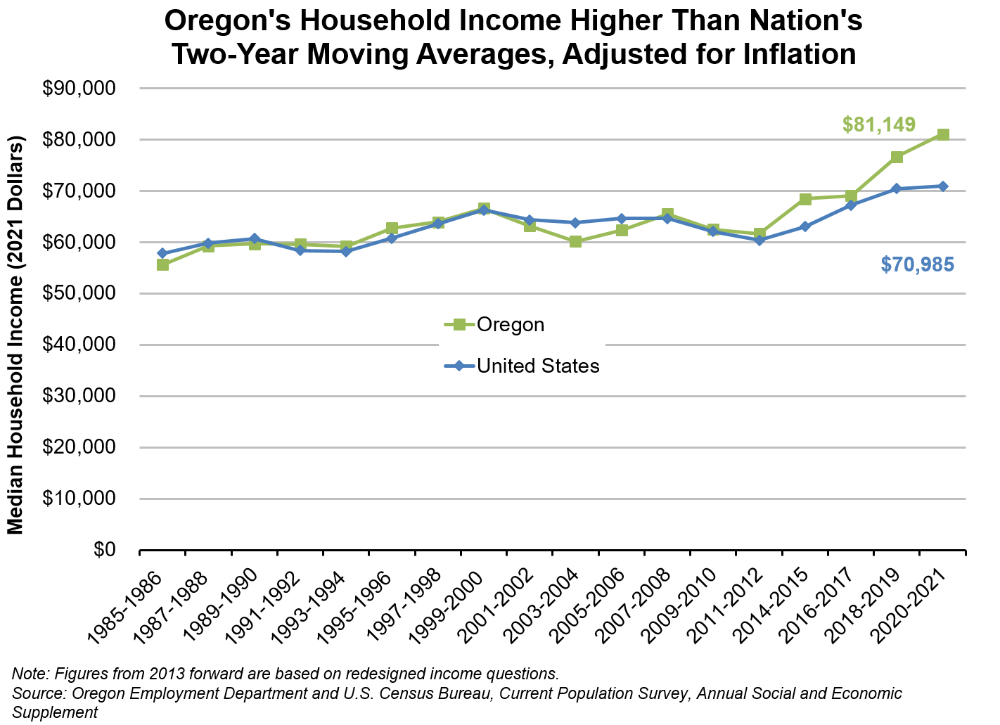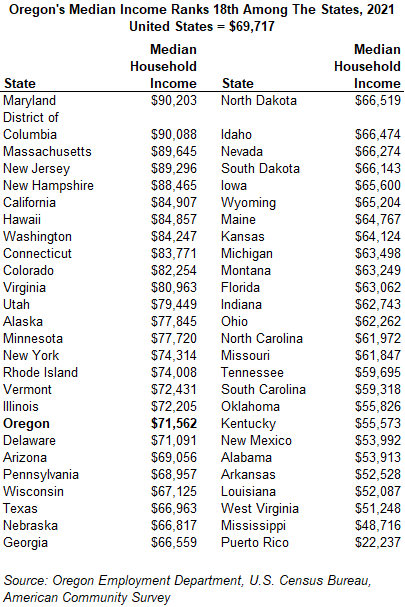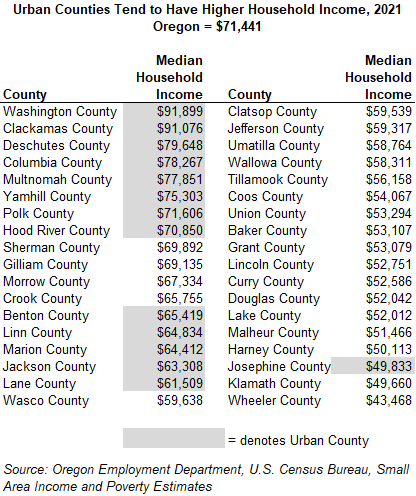A Closer Look at Oregon’s Median Household Income
June 1, 2023Oregon’s median household income reached $81,149 in 2021, which is higher than the U.S. median household income of $70,985. Median household income is an important reflection of economic well-being that’s based on the multiple income streams of people who live together. It can be used to compare the income of Oregonians over time, with the rest of the nation and in other states, among different types of households within Oregon, and in different areas of the state.
Measuring household income isn’t easy. Oregon has only one true median household income, which is unknown, but there are multiple ways to estimate it. This article looks at three sources of median household income estimates from the U.S. Census Bureau because each brings a different strength to the analysis.
Not surprisingly, the different sources create different estimates of household income. Each source shows that Oregon’s median household income isn’t drastically different from the U.S. Having more than one data source can lead to slightly different conclusions about the economy. That’s a good reason to take a closer look at Oregon’s median household income. We need to understand exactly how household income is defined and which source is the best in certain situations.
Let’s start with defining median household income. Then we’ll dig into the numbers.
Median
Median income is the point where half the households earn more and half earn less. If you lined every household up from lowest income to highest income, the median would be the income of the household that’s smack in the center.
Looking at median income instead of average (mean) income is helpful because the measure is less affected by households with extremely high incomes. Income distributions are skewed because they are bound by zero on the low end and essentially unbounded at the high end. The median is a better measure of center in such cases.
Household
There are 1,702,599 households in Oregon with an average size of 2.44 people, almost matching the U.S. average household size of 2.54 people.
A household is all the people who occupy a housing unit, such as a house, an apartment, a mobile home, a group of rooms, or a single room that is a separate living quarters. A household can consist of a single family, a person living alone, two or more families living together, or any other group of people who share living arrangements.
People not living in a housing unit are considered to live in group quarters and are not included in the median household income figures. Examples of group quarters include correctional facilities, nursing homes, mental hospitals, college dorms, military barracks, group homes, missions, or shelters.
Income
Income is the money received on a regular basis in the previous year or past 12 months by household members ages 15 years and over. This is before personal income taxes, social security, union dues, and Medicare deductions are removed.
It does not include noncash benefits such as food stamps, health benefits, subsidized housing, or goods produced and consumed on the farm.
Oregon’s Household Income is Similar to the Nation’s in Most Years
Oregon’s median household income has been very close to the U.S. over the past 30 years. There hasn’t been a statistical difference between Oregon and U.S. household incomes in most years. Over the past decade, Oregon’s job growth was stronger than the U.S. from 2013 until May of 2020. In the three years since, Oregon’s 12-month percent change in payroll employment has lagged the U.S. percentage change in 23 of those 36 months. Oregon ranks 30th fastest out of all states in job growth since the start of the pandemic.
Looking at trends among industry sectors, Oregon’s relatively slower employment growth compared with the nation is primarily due to slower recoveries in health care and leisure and hospitality, but our stronger gains in construction helped offset some of the weakness. Oregon’s private-sector average hourly real wage started rising in 2015, increasing from about $29.00 in the first quarter of 2015 to just over $34.00 per hour by the first quarter of 2023, adjusted for inflation. The Oregon Office of Economic Analysis recently noted, “After adjusting for inflation, total Oregon personal income is 3.5% higher than at the end of 2019 while the U.S. is up 2.6%. Oregon’s income growth ranks 21st fastest across all states. This relative strength is primarily in the non-wage forms of income.”

Personal income data published by the Bureau of Economic Analysis shows that Oregon per capita personal current transfer receipts as well as retirement and other income was higher than the U.S. in 2021. These trends helped propel Oregon’s median income to $68,507 in 2014-2015, higher than the U.S. median household income of $63,049. Oregon’s median remained higher than the U.S. in 2020-2021, coming in at $81,149 compared with the U.S. figure of $70,985.
Historical estimates of median household income are based on the Current Population Survey Annual Social and Economic Supplement (CPS ASEC). Each March, the survey asks a sample of households about their income in the previous year. This is the official source for national median household income estimates and is the recommended source for comparing national income with the states. It’s the source of the median household income figures in this article’s opening paragraph. However, the Census Bureau recommends using two-year averages when looking at state-level income trends prior to 2006.
The Census Bureau redesigned the CPS ASEC income questions starting with the 2013 data. This was done to improve income reporting, increase response rates, reduce reporting errors, and update questions on retirement income and income generated from retirement accounts and all other assets. The redesign created a data series break because data after 2013 is not directly comparable with data before 2013.
Oregon Has the 18th Highest Household Income
Oregon’s median household income ranked 18th in 2021 among the states, Washington, D.C, and Puerto Rico. Median household income is higher in neighboring states California and Washington, and lower in Nevada and Idaho.

The Census Bureau recommends using American Community Survey (ACS) estimates to compare median household income between states. The ACS surveys a lot more households (about three million nationally) than the CPS (about 100,000 nationally). The ACS’s larger sample size leads to income estimates with smaller margins of error and makes state comparisons more reliable.
According to ACS estimates for 2021, Oregon’s median household income was $71,562, which is about the same as the U.S. income of $69,717, when you consider the margin of error for the Oregon estimate of +/- $1,058. While Oregon’s median household income is higher in both the CPS-based estimates and the ACS estimates, the gap between the two is smaller in the ACS estimates. The difference is due to the number of households surveyed and the way the survey is conducted. For example, the ACS asks about income in the past 12 months, while the CPS asks about income in the previous year.
Income in Oregon isn’t drastically higher than the nation like it is in Maryland, Washington D.C., Massachusetts and New Jersey, or lower than the nation like it is in Mississippi, Arkansas, and West Virginia.
The ACS doesn’t have a long historical series like the CPS does. This makes it impossible to use ACS for long-term comparisons of state and U.S. income levels.
Income Differs Significantly by Type of Household
Out of the 1,649,352 households in Oregon, one-fourth of households (397,407) do not have any earnings income. All their income comes from investments (interest, dividends, or net rental income); Social Security; retirement or disability income; public assistance; or other types of income. They do not have earnings from wages or salaries for work performed as an employee, or net income (after expenses) from farm and nonfarm self-employment.
Household income varies by age of the householder. The highest median household incomes occur among householders between the ages of 25 and 44 ($81,572) and 45 and 64 years ($83,627). Median household income is just $38,592 when the householder is under 25 years, and it is $53,732 when the householder is 65 years and over. The householder is the adult in the household who owns or rents the housing unit. It can be either person when the house is owned or rented by a married couple.
Although the median household income in Oregon is $71,562, there are significant differences in household income between racial and ethnic groups. Household income is much higher when the householder is Asian ($93,857), and slightly higher than overall when the householder is white and not Hispanic or Latino ($72,853). Household incomes are lower than overall when the household is Black or African American ($60,927), American Indian and Alaska Native ($64,484), or Hispanic or Latino origin of any race ($63,296).
Household Income Highest in Washington County, Lowest in Wheeler County
Median household income ranges from a high of $91,899 in Washington County to a low of $43,468 in Wheeler County. Oregon’s urban counties tend to have higher median household incomes than rural counties.
The figures used in the national comparison of urban and rural household income are based on data collected by the ACS. For income estimates at the county level, the Census Bureau recommends using figures from the Small Area Income and Poverty Estimates (SAIPE) program. These are model-based estimates that combine data from administrative records, population estimates, the decennial census, and the ACS to produce household income estimates for areas with fewer than 65,000 people.
Oregon’s median household income is pretty close to the national median, and is slightly different depending on which estimate we look at. It’s slightly higher when looking at the official estimate for national household income, as well as when looking at the source that surveys more households. In some years, these comparisons can differ.

Household income can vary a lot depending on the age, race, and ethnicity of the householder. Location makes a difference too, as median incomes vary a lot by state and county, and households in urban counties generally have higher incomes than households in rural counties.